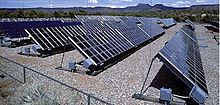Natural Bridges National Monument Solar Power System

Natural Bridges National Monument Solar Power System is a demonstration plant using solar cells as the energy source.[1][2][3][4][5][6][7]
When it was dedicated in June 1980 by the Utah Governor, it was the world's largest solar plant at 100 kW.[2] It is located in the southeastern portion of the state of Utah in the United States.[8]
History
The power plant, located in Natural Bridges National Monument, was a joint venture between the U.S. National Park System, the U.S. Department of Energy, and the Massachusetts Institute of Technology's Lincoln Laboratory. The array of solar panels are located on 1 acre (0.40 ha) near the park's visitor center. It has an observation platform overlooking the solar cells and recorded narration explaining the function of the facility. Natural Bridges' sunny climate makes it an ideal location for a solar cell power system. Its location far from available commercial power sources was a factor in site selection.[2]
The project cost $15 million ($39,699,000 in 2010 dollars), but a modern power plant would cost about $1.5 million because of technical advances in solar cell production.[8] The power plant operated for 10 years before it was shut down for overhaul and upgrading. The plant was downsized to 50 kW in 1993 and supplemented with a diesel generator backup system which allows the solar array to operate more efficiently.[8] The same year the restoration project added 18 kW of new solar modules, replaced the battery bank and upgraded the wiring. The existing power plant of solar cells provide 90 percent of the National Park community and visitor facilities electric power needs.[8]
Characteristics
The 100-kilowatt photovoltaic system power plant was 40 miles (64 km) from the nearest electric line and consisted of 266,029 solar cells arranged in 12 rows.[7] The power plant furnished the electricity for the visitors' center, six staff residences, maintenance facilities, and the local water sanitation system.[1] The system is protected with lightning rods.
There are 39 batteries weighing 1,200 pounds (540 kg) each with a combined capacity of over 600 kilowatt hours. 450 kWh is enough to operate the park for two days without sun. The solar control system limits the battery drawdown to 480 kWh by activating the diesel generator to increase battery life. The control system selectively sheds from one to 48 solar panels to prevent overcharging the battery system.[2]
Compared to diesel generators providing the same energy, there is an estimated savings of $34,000 per year in diesel fuel and maintenance costs by using a photovoltaic system. Also the environmental benefits include a reduction of air and noise pollution compared to diesel generators. The emissions reductions are estimated to be about 400 pounds (180 kg) of sulfur oxides, 2,100 pounds (950 kg) of nitrogen oxides, 170 short tons (150 t) of carbon dioxide, and 250 pounds (110 kg) of carbon monoxide annually.[8]
References
- ^ a b Anzovin, Steven; Podell, Janet (April 1, 2000). Famous first facts, international edition: a record of first happenings, discoveries, and inventions in world history. H.W. Wilson. ISBN 9780824209582..
- Item # 2070, p. 90 The first power plant using solar cells was dedicated in the United States on June 7, 1980, by Governor Scott Matheson at Natural Bridges National Monument, Utah, USA.
- ^ a b c d "National Park Service Solar Power System". Nps.gov. June 27, 2006. Retrieved April 13, 2011.
- ^ "Renewable Energy Timeline". University of Wisconsin. 2005. Retrieved April 13, 2011.
- ^ "Renewable Energy". UCLA. 2007. Retrieved April 13, 2011.
- ^ "The Ultimate Green Building". Maharishi University. 2009. Retrieved April 13, 2011.
- ^ "IMPORTANT AND INTERESTING EVENTS OF 1980". Dr. Isaac Newton Brown, Edworks, LLC. 2007. Retrieved April 13, 2011.
- ^ a b "The Generation Project: 1980 – 1984". Mark Verma. 2005. Retrieved April 13, 2011.
- ^ a b c d e Christine Wilkerson. "Natural Bridges National Monument Renewable Energy Project". Geology.utah.gov. Retrieved April 13, 2011.
